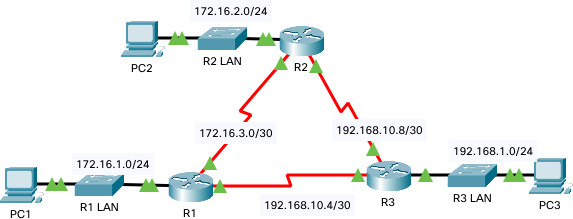In our last post, we took a look at a basic EIGRP configuration.
Now we’ll take a step back and consider some of the essential features of EIGRP.
EIGRP is a Cisco-proprietary dynamic routing protocol that debuted in 1992.
Although Cisco attempted to make it an open standard protocol a few years later, for all intents and purposes EIGRP is still largely used on Cisco routers.
In upcoming posts, we’ll consider more EIGRP features including Classic and Named modes, Authentication, Packet Types, Metric calculation, and Route Redistribution.
EIGRP: Essential Features
* Cisco-proprietary routing protocol (1992)
* Classless, advanced Distance Vector Routing Protocol
* In EIGRP, the topology information beyond the next hop is hidden (just like with the seldom-used RIP distance vector protocol)
* EIGRP only knows prefix and next-hop information
* EIGRP Administrative Distance (AD) is 90. Lower the AD, the more believable the Route is
* EIGRP uses the concept of Autonomous System to exchange routes
* An Autonomous System is nothing more than a collection of networks under the control of a single authority (RFC 1930)
* EIGRP Metric Calculation Relies on four components: Bandwidth, Delay, Reliability, Load, MTU
* By default, we consider only Bandwidth and Delay in calculating the EIGRP Metric
* Go with lowest Feasible Distance (more on that later)
* EIGRP Convergence technology is based on the Diffusing Update Algorithm (DUAL)
* Purpose of DUAL is to guarantee loop-free and backup paths throughout the EIGRP routing domain
* Partial triggered updates when a path or metric changes
* Provides both Equal & Unequal Cost Load Balancing
* EIGRP neighbors communicate via IP Protocol 88 by sending Hello Packets to Multicast address 224.0.0.10
* EIGRP uses concepts of Internal Routes (Originates from within an EIGRP Autonomous System) & External Routes (Redistributed from outside of EIGRP Autonomous System)
* Internal EIGRP Routes have AD of 90
* External EIGRP routes have AD of 170
* EIGRP relies on the key concepts of Hello Interval & Hold Time
* EIGRP Hello Interval – How long a local Router waits between sending Hello messages to a neighbor; Default Hello Interval on Broadcast NW: 5-seconds
* EIGRP Hold Time – Tells an EIGRP neighbor how long to wait before considering local router unavailable; Default Hold Time on Broadcast NW: 15-seconds
* EIGRP load balances across unequal cost links using the variance feature
* Supports Authentication with other EIGRP Routers
* Uses Reliable Transport Protocol (RTP) to deliver EIGRP Packets
* Update, Query & Reply packets require Acknowledgment; Hello & Acknowledgment packets do not require Acknowledgment
* EIGRP Does NOT work well in mixed environments


Sorry, the comment form is closed at this time.